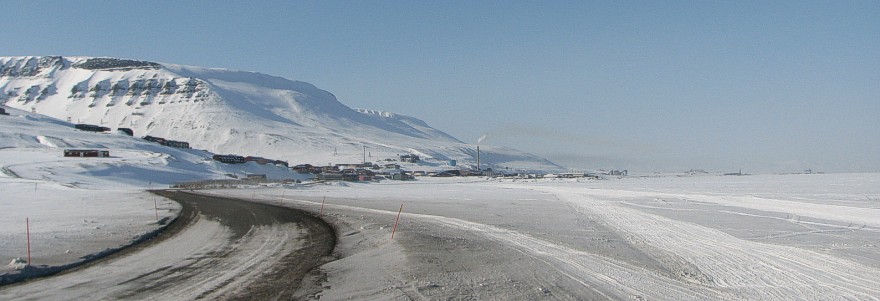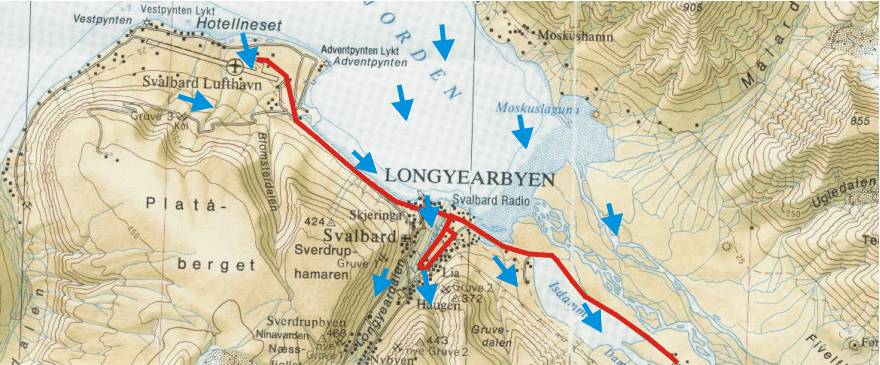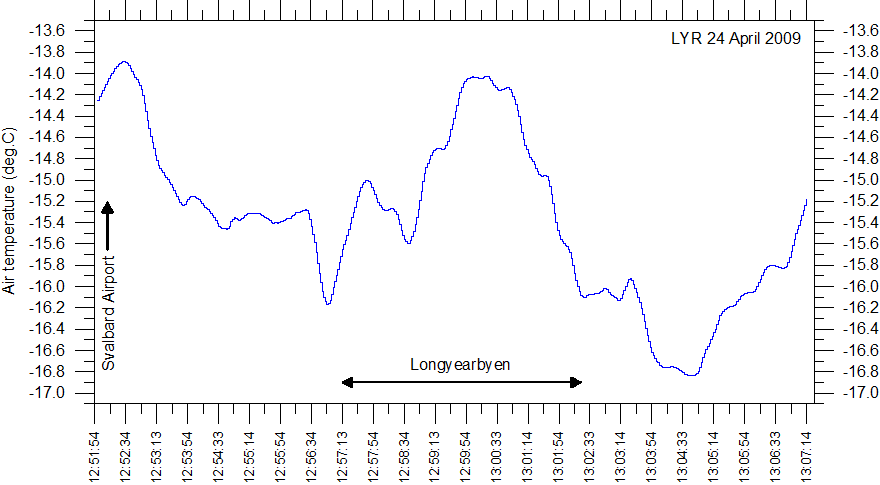Longyearbyen UHI experiment 24 April 2009
Open Climate4you homepage

Longyearbyen 24
April 2009 13:11 hr (summer time), looking WNW from the northern end of
the lake Isdammen (see map below). The sky was clear and without clouds. The wind
was very light from NNW, 0-0.5 m/s. The large building in the
distance to the right is the main hangar at Svalbard Ariport. Compare with map below.
The general weather
situation, measurement equipment and measurement route
The air temperature was about -15oC, and the wind very light from NNW, 0-0.5 m/s (see map below). The sky was clear. The ground was covered by snow, and the nearby fjord was ice covered (see photo above). A shielded thermistor was attached to the roof of a car (c. 1.5 m above terrain), and temperatures were logged at 2 sec. intervals. The time given in the diagrams below are using local summer time (true solar noon at about 13 hr). The measurements were carried starting at Svalbard Airport in the upper left of the map below, driving southeast along the coast to the town, making a round tour here, before proceeding southeast into the lower part of the large valley Adventdalen.
Longyearbyen
is the worlds northernmost town and is located at 78o17'N 11o20'E,
in central

Topographic map showing Longyearbyen and Svalbard Airport (Svalbard Lufthavn). The red line shows the measurement route 24 April 2009, starting at the Airport (location of the official meteorological station) and ending in the lower part of the valley Adventdalen to the SE. In between, a detour was made in the central part of the town as shown. The wind was very light from NNW, 0-0.5 m/s (blue arrows). The fjord was ice covered. The map section measures c. 13 km west to east.
Results

Result
of temperature measurements along the route Svalbard Airport - Longyearbyen
-Adventdalen, 24 April 2009. The official Svalbard meteorological station is
located at the airport. Se map above for reference.
Interpretation of results
The landscape was
snow covered, and the nearby fjord was ice covered. The route was sunlit and not shaded by topography or clouds at any
point, except shortly before entering Longyearbyen from NW.
At the airport, the
general air temperature was about -14oC. Leaving the airport,
the air temperature drops to about -15.5oC. The local temperature minimum
(-16.5oC) recorded shortly NW of Longyearbyen was caused by topographic shade.
In central Longyearbyen, the temperature increased to about -14oC.
Travelling inland along Adventdalen, air temperatures again decreased to -16.8oC, before increasing somewhat to about
-15.2oC at the end of the
measurement route.
The temperature peak at the airport is interpreted as the result of a limited heat release from some areas of the nearby fjord, where the ice cover was relatively thin (<0.5 m). The inner part of the fjord was covered with thicker ice, and the heat release therefore smaller. In Longyearbyen a clear urban heat island effect was apparently recorded, about 1-1.5oC. Further inland the air temperature again was lower, as the effect of heat release from the fjord disappears. On 24 April 2009, however, the heating effect of the fjord is much reduced compared to previous years, where the sea ice cover was absent or limited. Click here, here and here to see examples of this.
The
existence of an urban heat island effect in a relatively small settlement as
Longyearbyen may come as a surprise. This is, however, not the first time this
has been observed in the Arctic; see, e.g., Hinkel
et al. 2003.